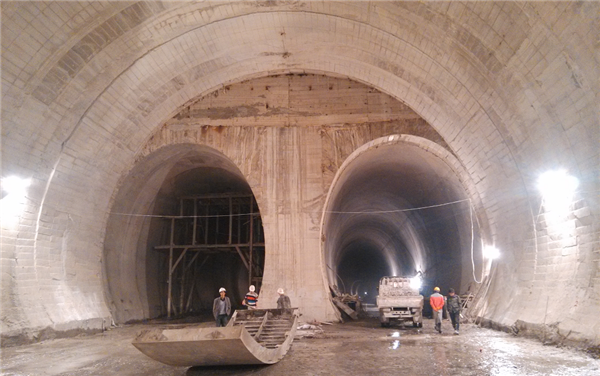
The picture shows Xinchengzi Tunnel with the world's largest squeezing surrounding rock tunnel section (350m2)
With the implementation of China's Western Development Strategy and the Belt and Road Initiative, a large number of national infrastructure projects are under construction or are about to be built, among which the construction of long and deeply-buried railway tunnels with squeezing surrounding rocks has become a major engineering problem. This kind of tunnel has the characteristics of strong geologic tectonic actions, extremely high ground stress level and remarkable rheological effect. The main difficulties in tunnel construction include: First, large deformation in surrounding rock (up to 100 ~ 300 cm) may easily cause safety accidents such as structural crushing and collapse. Second, there is no mature design method and deformation control technology against the high deformation rate (up to 10 ~ 25 cm/d) and complex mechanism, resulting in increased investment and prolonged construction period, often forming a key critical works. Third, deformation lasts for a long time (up to several months to several years), and it is difficult to control stability of the structure and ballast bed, which cannot meet the requirements of millimeter-scale deformation of railway track and affects the operation safety. Therefore, overcoming the technical difficulties in the design and construction of long and deeply-buried railway tunnels with squeezing surrounding rocks has become an urgent demand for traffic construction in western China.
Relying on more than 10 national, provincial and ministerial scientific research projects and a number of major engineering construction projects, with 10 years of scientific research and engineering practices by more than 100 scientific and technical researchers, a series of difficult issues in the construction of tunnels with squeezing surrounding rock have been solved, forming key technologies for the design and construction of long and deeply-buried railway tunnels with squeezing surrounding rocks. Major scientific and technological innovations are as follows:
1. The criteria for distinguishing squeezing surrounding rock and the classified prediction method for deformation potential have been established. The research has revealed the evolution mechanism of time-space stress and deformation in tunnels with squeezing surrounding rocks, put forward the geological criterion of squeezing surrounding rock, and established the classified prediction method for deformation potential in tunnels with squeezing surrounding rocks, which lays a theoretical foundation for design, construction and structural safety evaluation.
2. The design method for tunnels in squeezing surrounding rock with the whole process deformation control as the core has been established. Based on the nonlinear buckling principle, a synergistic interaction model of surrounding rock and support system has been established, a structural load calculation method of tunnels with squeezing surrounding rock has been proposed, and a structural system and design method for tunnels with squeezing surrounding rock based on moderate release, active reinforcement and strengthened support has been innovated, thus solving the key technical problems in structural design of tunnels with squeezing surrounding rocks.
3. A safe, efficient and controllable construction technology system for tunnels with squeezing surrounding rocks has been established. The construction method for tunnels with squeezing surrounding rocks based on deformation classification has been put forward, the key technology for deformation control construction of tunnels with squeezing surrounding rocks has been innovated, and the construction deformation control and management standard has been established, which provides guarantee for safe, efficient and high-quality construction and operation of long and deeply-buried railway tunnels with squeezing surrounding rocks.
The research result has solved the key technical issues in the design and construction of long and deeply-buried railway tunnels with squeezing surrounding rocks, and has been successfully applied to more than 60 tunnels such as Wushaoling Tunnel of Second Line of Lanzhou-Wuwei Railway, Tianpingshan Tunnel of Guiyang-Guangzhou HSR, Daliang Tunnel of Lanzhou-Xinjiang HSR, and Xinchengzi Tunnel in Lanzhou-Chongqing Railway. At present, it is also applied in the tunnels of Chengdu-Lanzhou Railway and Dunhuang–Golmud Railway. With a total application length exceeding 1,300km, it has brought remarkable economic and social benefits. The research result has greatly promoted the scientific and technological progress of the industry and provided important technical support for the construction of tunnels with squeezing surrounding rocks in the future, especially the extra-long and extra-deeply-buried ground stress tunnel to be constructed on Sichuan-Tibet Railway. It won the second prize of National Prize for Progress in Science and Technology 2019.
 附件:
附件:Copyright © 2015-2023 CHINA RAILWAY All Rights Reserved


